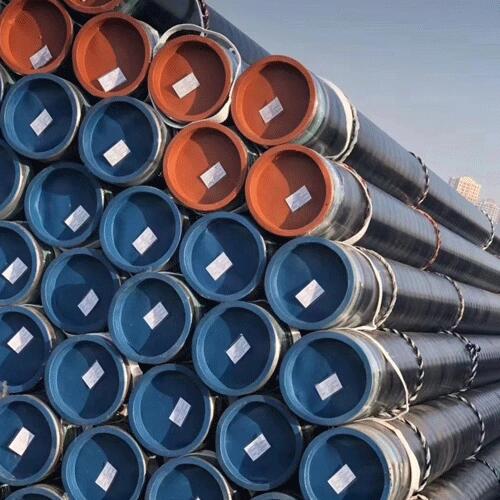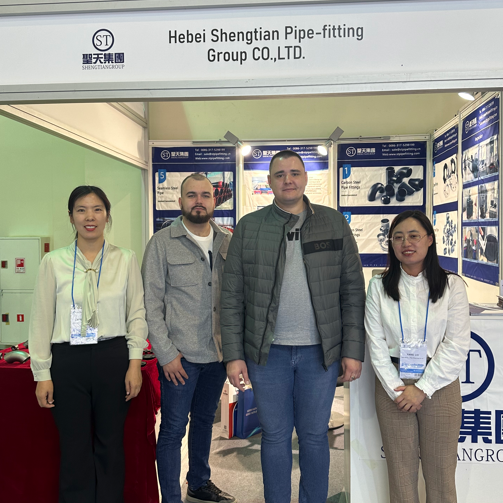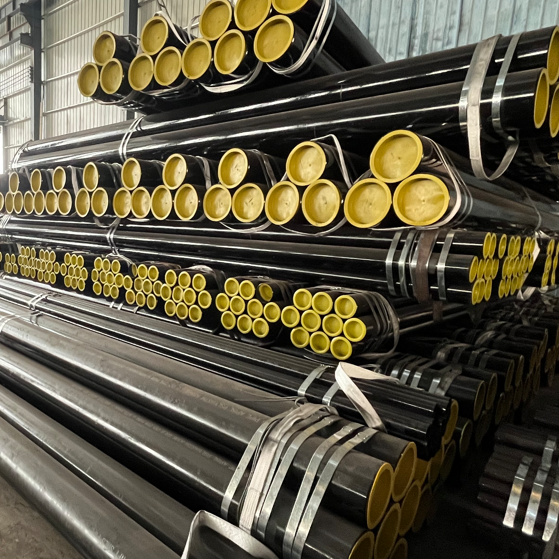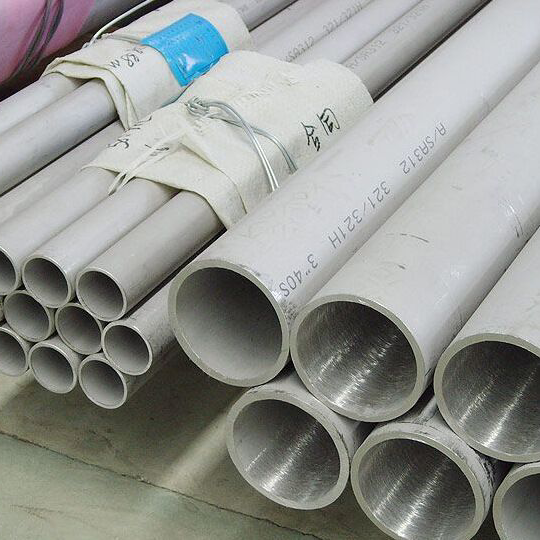★ According to the production method
Steel pipes can be divided into two categories according to production methods: seamless steel pipes and welded steel pipes. Welded steel pipes are referred to as welded pipes for short.
1. seamless steel pipes can be divided into hot rolled seamless pipes, cold drawn pipes, precision steel pipes, hot expanded pipes, cold spinning pipes and extruded pipes according to production methods.
Bundles of steel pipes
Bundles of steel pipes
Seamless steel pipe is made of high-quality carbon steel or alloy steel, which can be divided into hot rolling and cold rolling (drawing).
2. welded steel pipes are divided into furnace welded pipe, electric welding (resistance welding) pipe and automatic arc welded pipe due to their different welding processes. Due to their different welding forms, they are divided into straight seam welded pipe and spiral welded pipe. Due to their end shape, they are also divided into circular welded pipe and special-shaped (square, flat, etc.) welded pipe.
Welded steel pipe is made of rolled steel plate welded by butt joint or spiral seam. In terms of manufacturing method, it is also divided into welded steel pipe for low-pressure fluid transmission, spiral seam welded steel pipe, direct roll welded steel pipe, welded steel pipe, etc. Seamless steel pipes can be used in various industries, such as liquid and gas pipelines. Welded pipes can be used for water pipelines, gas pipelines, heating pipelines, electrical pipelines, etc.
★ Steel pipe material classification
Steel pipe can be divided into carbon pipe, alloy pipe, stainless steel pipe, etc. according to the pipe material (i.e. steel grade).
Carbon pipe can be divided into ordinary carbon steel pipe and high-quality carbon structural pipe.
Alloy pipe can be divided into low alloy pipe, alloy structure pipe, high alloy pipe and high strength pipe. Bearing pipe, heat and acid resistant stainless pipe, precision alloy (such as kovar alloy) pipe and high temperature alloy pipe, etc.
★ Classification of steel pipe connection mode
Steel pipes can be divided into: smooth pipe (pipe end without thread) and threading pipe (pipe end with thread).
Threading pipe is divided into ordinary threading pipe and pipe end thickened threading pipe.
The thickened threading pipe can also be divided into: externally thickened (with external thread), internally thickened (with internal thread) and internally and externally thickened (with internal and external thread).
Threading pipe can also be divided into ordinary cylindrical or conical thread and special thread according to the thread type.
In addition, according to the needs of users, the threading pipes are generally delivered with pipe joints.
★ Classification of steel pipe coating characteristics
According to the characteristics of surface coating, steel pipes can be divided into black pipes (not coated) and coated pipes.
Galvanized pipes, aluminum pipes, chromium pipes, aluminized pipes and steel pipes with other alloy layers.
Coated pipes include outer coated pipes, inner coated pipes and inner and outer coated pipes. The commonly used coatings include plastic, epoxy resin, coal tar epoxy resin and various glass type anti-corrosion coating materials.
Galvanized pipe is divided into KBG pipe, JDG pipe, threaded pipe, etc.
★ Steel pipes are classified according to use
1. pipes for pipes. For example, seamless pipes for water, gas and steam pipelines, oil transmission pipes, and pipes for oil and natural gas trunk lines. Taps with pipes for agricultural irrigation and pipes for sprinkler irrigation, etc.
2. pipes for thermal equipment. Such as boiling water pipes and superheated steam pipes for general boilers, superheated pipes, large smoke pipes, small smoke pipes, arch brick pipes and high-temperature and high-pressure boiler pipes for locomotive boilers.
3. pipes for mechanical industry. Such as aviation structural tubes (round tubes, elliptical tubes, flat elliptical tubes), automobile half axle tubes, axle tubes, automobile tractor structural tubes, tractor oil cooler tubes, agricultural machinery square and rectangular tubes, transformer tubes and bearing tubes, etc.
4. pipes for petroleum geological drilling. Such as: oil drilling pipe, oil drill pipe (Kelly and hexagonal drill pipe), drill stem, oil tubing, oil casing and various pipe joints, geological drilling pipe (core pipe, casing, active drill pipe, drill stem, collar and pin joint, etc.).
5. pipes for chemical industry. Such as: petroleum cracking pipes, pipes for heat exchangers and pipelines of chemical equipment, stainless acid resistant pipes, high-pressure pipes for chemical fertilizers, and pipes for transporting chemical media.
6. pipes for other departments. Such as: container tubes (high-pressure gas cylinder tubes and general container tubes), instrument tubes, watch shell tubes, injection needles and their medical devices.
Classification of steel pipe section shape
Steel pipe products have a wide variety of steel types and specifications, and their performance requirements are also various. All these shall be distinguished according to the change of user requirements or working conditions. Generally, steel pipe products are classified according to section shape, production method, pipe making material, connection mode, coating characteristics and application, etc.
★ steel pipes can be divided into round steel pipes and special-shaped steel pipes according to the cross-sectional shape.
★ steel pipes are divided into equal section steel pipes and variable section steel pipes according to the vertical section shape. Variable cross-section (or variable cross-section) steel pipe refers to the steel pipe whose cross-section shape, internal and external diameter and wall thickness change periodically or aperiodically along the pipe rectangle. They mainly include: outer tapered pipe, inner tapered pipe, outer stepped pipe, inner stepped pipe, periodic section pipe, corrugated pipe, spiral pipe, steel pipe with heat sink and gun barrel with double line, etc.
 ASTM A106 Thick-walled steel pipe production steps
ASTM A106 Thick-walled steel pipe production steps
 Shengtian Group successfully participated in the Russian Oil and Gas Exhibition
Shengtian Group successfully participated in the Russian Oil and Gas Exhibition
 Is API 5L Black Steel Pipe Good For Air Lines?
Is API 5L Black Steel Pipe Good For Air Lines?
 8 differences between ASTM A312 304 and 316 stainless steel pipes
8 differences between ASTM A312 304 and 316 stainless steel pipes